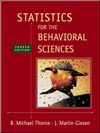 |  Statistics for the Behavioral Sciences, 4/e Michael Thorne,
Mississippi State University -- Mississippi State
Martin Giesen,
Mississippi State University -- Mississippi State
Probability
Symbols and FormulasSYMBOLS | Symbol | Stands For |
| | p(A) | probability of event A | | p(A or B) | probability of event A or event B | | p(A, B) | probability of both A and B | | p(B|A) | probability of event B given that event A has occurred |
FORMULAS Formula 7-1. Equation for the addition rule of probabilityp(A or B) = p(A) + p(B)
p(A or B) means the probability of either event A or event B, and it is equal to the probability of event A
[p(A)] plus the probability of event B [p(B)].
Formula 7-2. Equation for the multiplication rule of probabilityp(A, B) = p(A) x p(B)
p(A, B) is the probability of occurrence of both event A and event B, which is equal to the product of their
individual probabilities. This equation is used when events A and B are independent. Formula 7-3. Equation for determining the probability of a sequence of nonindependent eventsp(A, B) = p(A) x p(B|A)
When events A and B are not independent—that is, when the probability of B depends on whether A has
occurred—then the multiplication rule must be modified as shown. p(B|A) reads "probability of B given A." |
|



 2003 McGraw-Hill Higher Education
2003 McGraw-Hill Higher Education